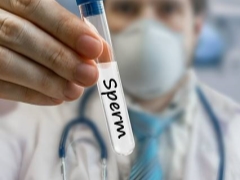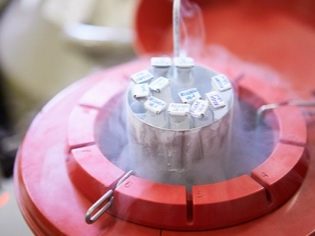Sperm storage methods, cryopreservation
A man’s donor or own sperm may remain useful one year after donation, if it is properly stored. In Russia and around the world, the method of cryopreservation of ejaculate is widespread. Sperm banks, which exist on their own, as well as at clinics that provide reproductive support services to infertile couples - IVF, insemination, are engaged in storage. Are there any other ways to preserve a biomaterial without losing its quality and how storage occurs, we will tell in this article.
Frost
Cryopreservation is one of the main ways of storing germ cells. The impact of low temperatures allows you to keep the cell in a viable state, simply plunging it into a kind of suspended animation, in which all metabolic processes inside the cell slow down. The sperm acrosome apparatus undergoes changes and this prevents the cell from losing its fertilizing abilities.
It should be noted that anabiosis sperm cells are also exposed in the host's testicles, because until the moment of ejaculation, when the gametes are mixed with seminal fluid, the germ cells remain in complete immobility. Only this anabiosis has a chemical origin: this is how gametes behave under the influence of certain acids. The property of spermatozoa to fall into anabiosis was noticed by scientists in the middle of the 20th century, at the same time they began experiments on freezing them.
When the ejaculate is needed, the sperm will be thawed, cleaned of impurities and semen and used in the IVF protocol. This applies to both donor and male sperm. If very high demands are made on the donor, then any adult man can deposit his own biomaterial. The reasons for this among the representatives of the stronger sex can be any number. Consider the most common ones.
- Dangerous jobin which a man who is already married, but has not yet had time to have children, may die. If desired, the spouse will be able to use spouse sperm for IVF.
- Work in hazardous production, in terms of radiation, in contact with nitrates, salts of heavy metals, paints and varnishes, which have a destructive effect on spermatozoa in particular and male fertility in general.
- Upcoming cancer treatment (During chemotherapy, gametes, as cells that behave most actively, suffer greatly, which then can lead to infertility).
- The upcoming surgical treatment of reproductive organs pathologies or a man’s desire to use a vasectomy for contraception.
- Professional sport (for example, cycling or wrestling), in which the risk of injury to the external genitalia is high.
- Spinal cord injuries and post-traumatic paralysis (it is better to deposit the sperm immediately after the injury, since long-term dysfunction of the spinal cord affects the state of spermatogenesis. Sometimes sperm can be collected with a paralyzed lower body only surgically).
Also in recent years, there are representatives of the stronger sex, who plan to use the program "deferred paternity." A man can save his biomaterial just for no apparent reason, if in the near future he is not going to become a dad, if he has not yet met his beloved and the only one with whom he would like to give birth to a child.
Of course, a man can become a dad at 70, and history knows many such examples. But, alas, the quality of the ejaculate does not improve with age, and poor ecology, taking various medications, and bad habits can lead to mutational processes in the DNA set of its spermatozoa. For this, there is a program of postponed paternity, so that at any age, if necessary, there is an opportunity to conceive a healthy and full-fledged child.
Storage conditions should be such that at least 60% of the germ cells survive, and the main characteristics of the ejaculate remain unchanged after defrosting. Only then will the sperm be suitable for use.
Knowing that not all gametes will survive, a man should prepare for the delivery of sperm in order to increase its quantitative and qualitative indicators. So, for 5-6 days it is not recommended to have sex and masturbate. For a couple of weeks before surrender, you should not go to the bath and sauna, wear tight underwear or tight-fitting pants that tighten the pelvis and can cause circulatory disorders in it.
A man before the delivery of sperm must eat fully, in his diet should be meat and fish, dairy products, fresh greens. Alcohol is contraindicated, and nicotine is highly undesirable. You should avoid taking antibiotics, hormonal drugs.
Doctors first dilute the sperm slightly, and then place it in a centrifuge to obtain a pure gamete fraction. About a quarter of an hour the material is spent in tanks with cryoprotective fluid. This is necessary in order to protect the sex cells in shock freezing.
The resulting fractions are placed in special containers for freezing. First, the sperm are cooled in a freezer, then placed in liquid nitrogen, dropping the temperature to minus 96 degrees Celsius. And only then, after two hours, the containers with centrifuged ejaculate are placed in a special vessel, the temperature in which is maintained at minus 196 degrees.
Store sperm in a cryobank at exactly this temperature. Shelf life - up to 20 years and even more. Any fluctuation, even by 1-2 degrees, can lead to dysfunction of the cells after defrosting. It is for this reason that you should not even try to freeze the sperm yourself.
It will not be stored in the freezer or in the refrigerator. The intracellular fluid will simply turn into ice crystals and tear the sperm membrane, killing it. Only a shock freezing with observance of the subsequent conditions under which they store frozen sperm, can guarantee that the gametes retain their properties, and the man can become a dad, even after a few years.
The cost of freezing starts from 5 thousand rubles, then monthly (or annual) payment is charged for the preservation of biomaterial in a cryobank (from 1000 rubles per month). You can pay in advance for the year, you can - for six months or monthly (it depends on the conditions stipulated by the contract with the clinic).
Defrosting is strictly in reverse order with the observance of time intervals and temperature changes. After thawing, sperm should be used within 1.5-2 hours.
Short-term conservation
This method of storage does not imply the impact of low temperatures on gametes, but does not guarantee long-term storage. Preservation occurs in an electrolyte-free environment. For example, sperm cells can be placed in an aqueous solution of glucose. How and why germ cells maintain their basic functions with such conservation, science and medicine are not yet completely clear, but the fact remains.
A big and important plus in comparison with cryopreservation is that during storage in this way, the integrity of the potassium and calcium channels is not even remotely disturbed. Sperm cells practically do not die during such storage.
However, the method can only be used when sperm is planned to be used in the near future.Long-term storage of this method does not provide. Usually the method can be applied if IVF using a biomaterial is prescribed a few days after the delivery of the ejaculate. Doctors note that sometimes sperm in such an environment retains translational movements even after a week of storage, but the fertilizing ability of such sperm is already much lower.
other methods
Scientists have repeatedly tried to develop other ways to preserve male sex cells, for example, in a dried state, but none of the experiments has so far been crowned with success. Thus, while there are only two ways, which we described above.
Efficiency
Women (and men too) are worried about whether freezing or ordinary electrolyte-free preservation will affect the quality of the resulting embryos and the success of the IVF procedure. Cryopreserved sperm has all the same characteristics as fresh, with the only difference that some spermatozoa die during thawing. The degree of loss will depend on how correctly the freezing procedure was carried out and on whether all the requirements were met during the defrosting of the biomaterial.
The egg cell fertilized by thawed sperm is no different from the oocyte, which was fertilized with fresh spermatozoa. The success rate of IVF does not change significantly.
When using sperm, which was conserved in an aqueous solution of glucose without freezing, the chances of fertilizing the egg are somewhat higher, since spermatozoa are better in quality. This, however, is also not significantly affected by the success rate of an in vitro fertilization protocol.
See the next video for the details of cryopreservation of sperm.























